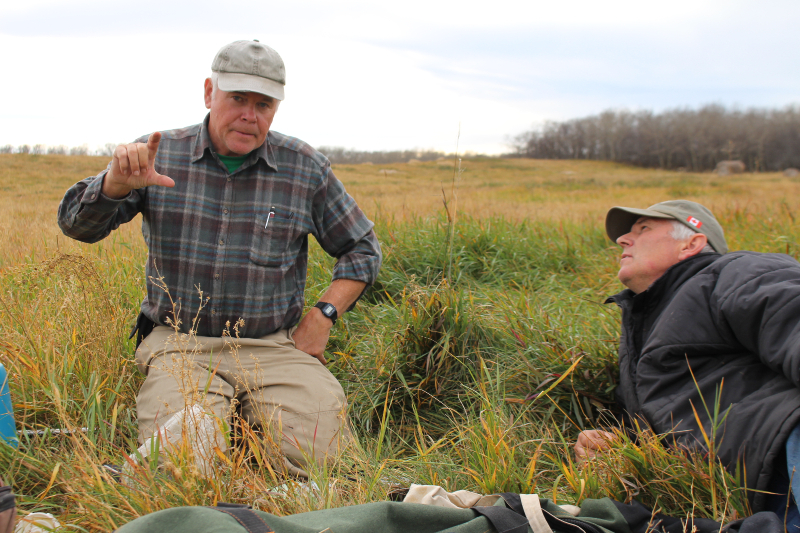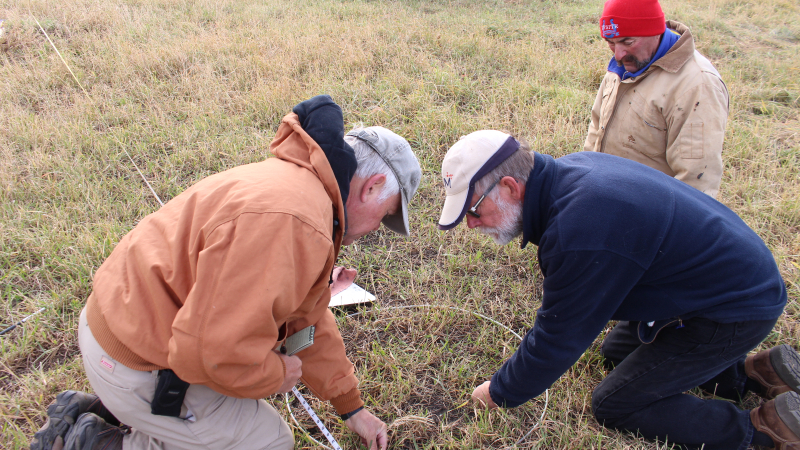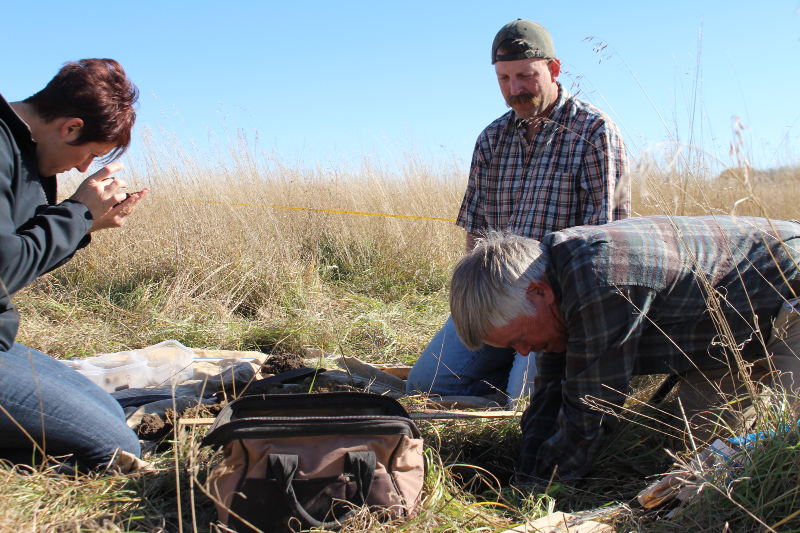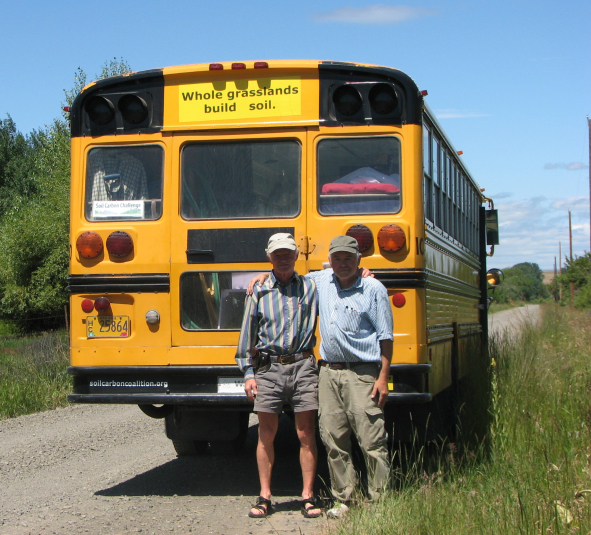 |
| Peter Donovan and Ralph Corcoran. Photos by Didi Pershouse. |
Sometimes it has been lonely. Often there have been unexpected gifts of friendship and hospitality. In the 30,000 miles of travel in my school bus home, plus many thousands more by train, bus, plane, and car in the U.S., Mexico, and Canada, I have glimpsed bits and pieces of a miracle: a growing interest and commitment, by many people, to growing soil and regenerating land.
Since 2010 I’ve established about 270 baseline carbon plots in the US, Mexico, and Canada. As we start re-monitoring we now get to see results, not just baselines, which means we can track the actual changes in soil carbon and plant cover over time. These can teach us, one plot at a time, what is actually possible when creative and committed people work with the most powerful and creative planetary force.
The Soil Carbon Challenge is an international (and localized) competition to recognize land managers who are growing water-holding, fertility-enhancing soil organic matter. It is designed for those who are, or will be, managing for more carbon and water in their soils and enhanced ecological function, and who want feedback and accountability relative to this goal. We seek to recognize grassroots leadership, to help discover what is possible through management of the most powerful and creative planetary force, and to help build management capacity at all scales from society to individuals managing land.
Northeast Oregon: Tony and Andrea Malmberg of Union, Oregon had a 23% increase in soil carbon in the top 10 centimeters (about 4 inches) after not quite three years, following a transition from 23 years in the Conservation Reserve Program where no farming or grazing was done, to planned grazing beginning in October 2010. Above-ground plant diversity increased as well.
 |
| Peter Donovan, Blain Hjertaas, and Neil Dennis |
Southeast Saskatchewan: Every one of the 5 farms with baseline plots that Blain Hjertaas and I remonitored in October 2014 showed substantial increases in soil carbon, over 40 percent in some cases (see links below to graphs and summary data for all layers sampled). These plots are in pastures, mainly smooth brome or meadow brome, and bluegrass. These graziers are all using some type of planned grazing, with fairly short times of exposure to grazing and fairly long recovery periods. In some cases, they have given their cattle access to round bales of hay spaced around the field for winter supplement. None of the plots were located in the rings of lusher grass growth that persist for some years around the location of each bale, but some hay feeding did occur over the plot SUNB1 and the surface litter there did contain hay residue.
Blain Hjertaas, who has helped a group of graziers in southeast Saskatchewan learn planned grazing and holistic management, noted the excellent growing conditions over the last three years.
Neil Dennis, one of the Saskatchewan graziers who is featured in the film "Soil Carbon Cowboys," has used high stock density and recovery periods of 80 days or longer for years on his pastures of brome and bluegrass. “As your land gets healthier, your recovery time should get longer. Everything starts changing when you get healthier land—the health of the animals, and the response of the grass. My brome hasn’t set seed in a year.”
See graphic plot summaries here as well as on the map.
The sampling methods are detailed in Measuring Soil Carbon Change: A flexible, local, practical method, available here.
These results mean that some dedicated land stewards, by turning atmospheric carbon into soil carbon, are growing soil and soil structure. This has a large influence on water-holding capacity, yearlong productivity, profit, quality of life, and the well-being of their communities. They are doing this with the tools and resources that are already available on their farms, namely sunlight, rain, plants, livestock, countless microbes, and well-directed human management.
Notes Soil Carbon Coalition cofounder Abe Collins: "Practical, visionary ranchers and farmers are leading the way in discovering how to grow new topsoil. By tracking change in soil carbon levels via the Soil Carbon Challenge they've gained important feedback.
"We hope that soil health outcomes of these ranchers' good management also expands the sense of possibility and encourages action toward a deep topsoil future by the non-farming public.
"The Soil Carbon Coalition continues to develop and implement open monitoring and data analysis tools designed to increase people's capacity to achieve topsoil and water security wherever they live."
 |
| Carolyn and Trent Wall, Peter Donovan |
The Soil Carbon Coalition will continue to help develop local interest and capacity in measuring change in soil carbon, using open data and practical methods. I’ve given workshops in Mexico, Vermont, and Pennsylvania and have more scheduled for 2015. We would like to see the Challenge be taken up (and localized) in all areas of the world, with open shared data. For those of you who are participating in the Soil Carbon Challenge, please contact me to request remonitoring or for instructions on accessing your baseline data.
Mapping power and change: an expansion of our work
Life, as the Russian geochemist Vernadsky observed nearly a century ago, is the most powerful geologic force. Yet we are ill-suited to recognize or enlist this most powerful and creative planetary force, because we generally don’t monitor landscape function. Instead we spend vast sums on predictions, models, and on mapping problems, species, and land cover, and then on research to establish best and worst practices for addressing these problems.
Big data, citizen science, and open-data technologies are coming together to create an opportunity for open, participatory, multilayered maps of landscape function and change over time that build on our mapping of soil carbon change. The Soil Carbon Coalition is looking for collaborators and partners in building out our open-data infrastructure into a participatory Atlas of biological work—the most powerful and creative planetary force. A design is outlined here:
http://soilcarboncoalition.org/atlas
This will be a platform to raise bigger questions, to recognize and develop local answers, and to build management capacity in complex situations through monitoring at all scales, from national governments to watersheds, local conservation districts, and individuals managing land.
Acknowledgments
The Soil Carbon Challenge owes its start as well as its future to the many participants interested in managing toward more soil structure and greater soil health, who have been the primary funders and drivers of this effort, and who have been hosts along the journey. Thanks for good food and firewood and places to camp, for sharing your lives and dreams, and most of all for your example and leadership.Many have advised us in the design and implementation of measurement methods, especially Christine Jones (amazingcarbon.com) and Craig Stubler of California Polytechnic State University. We have received funding during the last few years from the Dixon Water Foundation, from the 11th Hour Project of the Schmidt Family Foundation, from the TomKat Ranch Educational Foundation, and from the San Benito Community Foundation.
 |
| Doug McDaniel of Lostine, Oregon (left) has been a huge help and support. Thanks Doug! |
Above all, we seek participation, working together. If you believe your land management is worth monitoring, if you want to help with or organize monitoring in your community or region, if you can contribute data on soil carbon change from other efforts, if you are interested in contributing, collecting, and mapping data on the most powerful and creative planetary force, please contact us.
Peter Donovan Soil Carbon Coalition soilcarboncoalition.org/about
Recent Posts
Archive
Categories
- Events (2)
- policy and framing (20)
- ruminations (3)
Tags
- atlas (2)
Authors
- Peter Donovan (133)
- Didi Pershouse (3)